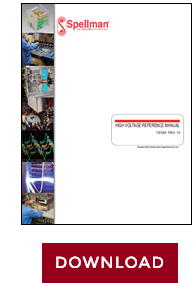High Voltage Reference Manual
Everything you would ever want to know about high voltage, all in one place
 As one of the world’s leading designers and manufacturers of high voltage power conversion devices, we’ve amassed a wealth of knowledge that we are happy to share with our customers and partners. Our High Voltage Reference Manual is a compilation of all these useful FAQ’s, application notes, articles, technical papers and three glossaries in a single handy document.
As one of the world’s leading designers and manufacturers of high voltage power conversion devices, we’ve amassed a wealth of knowledge that we are happy to share with our customers and partners. Our High Voltage Reference Manual is a compilation of all these useful FAQ’s, application notes, articles, technical papers and three glossaries in a single handy document.
We welcome you to download the guide and learn more about this exciting technology.
Technical Resource Manual
Table of Contents
Section 1
FAQs High Voltage Power Supplies & Safety
ARC/Short Circuit
Are your supplies current protected?
Why is the short circuit repetition rate of my load set-up important?
What is the difference between instantaneous short circuit current and continuous short circuit current?
Why is arcing an issue for a high voltage power supply?
Interfacing
What kind of high voltage connector do you use on your supplies?
Can I program your supplies with a computer?
What do you mean that the output side of the high voltage cable on most standard products is “unterminated”?
Safety
What is a safe level of high voltage?
Where can I obtain information on high voltage safety practices?
What is an "External interlock"? Why should I use it?
IEEE std 510-1983 IEEE recommended practices for safety in high voltage and high power testing
Technology/Terminology
What is the difference between a modular supply and a rack supply?
What is the difference between voltage mode and current mode?
Voltage mode/current mode. Why a power supply can only regulate one of these parameters at a time?
What is power control? When would it be used?
What is floating ground?
What is solid encapsulation?
Why is oil insulation used?
What is corona?
What is a voltage multiplier?
What is a resonant inverter?
What is a high voltage power supply?
Linear versus switch mode power supplies?
What is a stack type high voltage power supply?
Why are corona rings/toroids/balls used on high voltage power supplies?
What is ball soldering?
Usage/Application
Positive polarity, negative polarity, reversible polarity; why is this important when I purchase a supply?
Can I run your supplies at maximum voltage? Maximum current?
Can I get twice the current from your supply if I run it at half voltage?
Why is the fall time of your supplies load dependent?
How should I ground your supply?
Can I float your supplies?
Can I operate your 220VAC power supplies at 230VAC?
Why do I have to provide a current programming signal to the power supply?
Why do I have to fill out a capacitor charging questionnaire if I’m going to use your power supply for capacitor charging?
What are the bandwidth capabilities of the HVD series of high voltage dividers?
What is power factor? What is the power factor of a switching power supply?
Can I operate a high voltage power supply designed for 220vac, single phase from a 208vac, three phase electrical service?
Section 2
Monoblock® Cooling Recommendations
Monoblock® Warm-up/Seasoning Procedures
Monoblock® FAQ’s
Cooling
Do I need to ensure my Monoblock® stays cool? Why?
Maintenance
What periodic maintenance do I need to perform for my Monoblock®?
Minimum Settings
Is there a minimum current and voltage I can set my Monoblock® to?
Mounting
Are there any special considerations for the mechanical mounting of the Monoblock®?
Seasoning
How often do I need to season my Monoblock®?
Dose Stability
How does X-Ray dose stability relate to voltage/current stability?
Long Term Storage
Is it ok to keep a Monoblock® in storage, unused for long periods of time?
Tube Life
Will the X-Ray tube last forever?
Section 3
Application Notes HVPS
AN-01
What do you mean; the output is “ground referenced”?
AN-02
“Ground is ground”, right? What you need to know.
AN-03
You wouldn’t use a pickaxe for dental surgery: when over specifying a power supply can be a bad thing.
AN-04
How low can you go? Why signal to noise ratios are important in programming high voltage power supplies.
AN-05
"No, you touch it". HVPS output fall and discharge times explained.
AN-06
“Just jumper the external interlock”? Why you really shouldn’t.
AN-07
What’s the voltage rating of RG8-U coaxial cable?
AN-08
How do I change the polarity of the power supply?
AN-09
Why do power supplies take time to warm up?
AN-10
Fixed polarity, reversible polarity, four quadrant operation…a simple explanation.
AN-11
High voltage power supply dynamic load characteristics.
AN-12
The benefit of using a current source to power X-Ray tube filament circuits.
AN-13
Arc intervention circuitry and external series limiting resistors.
AN-14
The limits of front panel digital meters.
AN-15
3.5 and 4.5 digit meter displays explained.
AN-16
Parallel capability of the ST series.
AN-17
High voltage power supply programming resolution explained.
AN-18
Current loop/arc detection circuitry.
AN-19
Keep it short if you can. High voltage cable lengths discussed.
AN-20
Grounding for high frequency transients due to arcing events.
AN-21
How to calculate maximum ac input current.
AN-22
Simple voltage mode/current mode testing of a high voltage power supply.
AN-23
SL HV off and HV on circuitry explained.
AN-24
Environmental considerations for Spellman high voltage power supplies, X-Ray generators and Monoblock® X-Ray sources.
AN-25
My high voltage power supply is arcing. How can I figure out where the problem is?
AN-26
Capacitor charging and Spellman high voltage power supplies.
AN-27
What does the fault “regulation error” mean?
AN-28
Pulsing applications and Spellman high voltage power supplies.
Section 4
Application Notes X-Ray Generators
AN-01
Fundamentals of X-Ray generator—X-Ray tube optimization.
AN-02
Common X-Ray tube failure modes.
AN-03
Floating filament X-Ray generators and the possible problems that long high voltage cables can produce.
Section 5
Technical Articles about HVPS & HV Electronics
Power Supply Use and Application
IEEE std 510-1983 IEEE recommended practices for safety in high voltage and high power testing.
Standard test procedures for high voltage power supplies.
Specifying high voltage power supplies.
High voltage power supplies for analytical instrumentation.
High voltage power supplies for electrostatic applications.
A product development process for high voltage power supplies.
Next generation in power feed equipment.
High voltage power supply technology for use in power feed applications.
Functional role of X-Ray generators in industrial applications.
Section 6
Technical Articles about HVPS & HV Electronics
Research Papers
Design and testing of a high-power pulsed load.
Accurate measurement of on-state losses of power semiconductors.
Highly efficient switch-mode 100kv, 100kw power supply for ESP applications.
High power, high efficiency, low cost capacitor charger concept and implementation.
Comparative testing of simple terminations of HV cables.
A high power, high voltage supply for long pulse applications.
Comparison of dielectric strength of transformer oil under dc and repetitive multimillisecond pulses.
Behavior of HV cable of power supply at short circuit and related phenomena IEEE transactions on dielectrics and electrical insulation
Analysing electric field distribution in non-ideal insulation at direct current
Section 7
Applications Glossary
Section 8
Technical Glossary
Section 9
GXR Glossary




